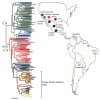Coccidioides Species: A Review of Basic Research: 2022
- PMID: 36012847
- PMCID: PMC9409882
- DOI: 10.3390/jof8080859
Coccidioides Species: A Review of Basic Research: 2022
Abstract
Coccidioides immitis and posadasii are closely related fungal species that cause coccidioidomycosis. These dimorphic organisms cause disease in immunocompetent as well as immunocompromised individuals and as much as 40% of the population is infected in the endemic area. Although most infections resolve spontaneously, the infection can be prolonged and, in some instances, fatal. Coccidioides has been studied for more than 100 years and many aspects of the organism and the disease it causes have been investigated. There are over 500 manuscripts concerning Coccidioides (excluding clinical articles) referenced in PubMed over the past 50 years, so there is a large body of evidence to review. We reviewed the most accurate and informative basic research studies of these fungi including some seminal older studies as well as an extensive review of current research. This is an attempt to gather the most important basic research studies about this fungus into one publication. To focus this review, we will discuss the mycology of the organism exclusively rather than the studies of the host response or clinical studies. We hope that this review will be a useful resource to those interested in Coccidioides and coccidioidomycosis.
Keywords: Coccidioides immitis; Coccidioides posadasii; coccidioidomycosis; dimorphic fungus; fungus; microbiology; mycelium; mycology; pathogenesis; spherule.
Conflict of interest statement
The authors report no conflict of interest. The funders played no role in the interpretation of data or the prepation of this manuscript.
Figures















References
-
- Hector R.F., Rutherford G.W., Tsang C.A., Erhart L.M., McCotter O., Anderson S.M., Komatsu K., Tabnak F., Vugia D.J., Yang Y., et al. The public health impact of coccidioidomycosis in Arizona and California. Int. J. Environ. Res. Public Health. 2011;8:1150–1173. doi: 10.3390/ijerph8041150. - DOI - PMC - PubMed
Publication types
Grants and funding
- VFR-19-633952/Valley Fever Research Initiative at the University of California
- R00GM135515/GM/NIGMS NIH HHS/United States
- U19AI166059, R01AI137418, R21 AI149015, R01 AI135005, U19AI16676, R01 AI148336/National Institute of Allergy and Infectious Diseases
- R01 AI148336/AI/NIAID NIH HHS/United States
- U19 AI166059/AI/NIAID NIH HHS/United States
LinkOut - more resources
Full Text Sources
Miscellaneous

